Introduction
In the vast culinary landscape of Asia, traditional dishes often serve as a bridge between generations, encapsulating flavors and techniques that have been handed down through centuries. One such dish, hailing from the heart of China and beloved across Southeast Asia, is Steamed Taro Root and Pork Ribs (commonly known as Binglangyu Zheng Paigu in Mandarin). This dish combines the creamy, starchy sweetness of taro root (Colocasia esculenta) with the tender, savory meat of pork ribs, all steamed to perfection in a fragrant blend of seasonings.
The beauty of steaming lies in its ability to preserve the natural flavors and textures of ingredients while infusing them with aromatic herbs and spices. This cooking method not only retains moisture but also ensures that the nutrients are locked in, making it a healthy choice for modern diners. In this comprehensive guide, we will delve into the intricacies of preparing Steamed Taro Root and Pork Ribs, from selecting the freshest ingredients to mastering the steaming technique. By the end, you’ll be equipped to create a dish that is as visually appealing as it is deliciously comforting.
Section 1: Ingredient Selection and Preparation
1 Pork Ribs
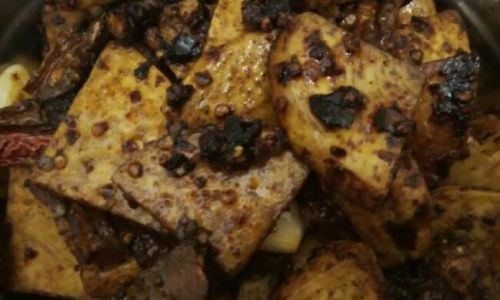
The foundation of any good steamed pork dish is the quality of the meat. For Steamed Taro Root and Pork Ribs, opt for pork spare ribs or baby back ribs. These cuts offer a balance of meat and bone, with the latter providing natural flavor and moisture during cooking.
-
Selection Criteria: Look for ribs that are meaty, with a good marbling of fat. Avoid ribs that appear dried out or have too much surface fat. Freshness is key; ensure the meat has a bright, slightly tacky appearance and a clean, slightly sweet smell.
-
Preparation: Trim any excess fat and sinew from the ribs. Cut them into individual portions if they are not already separated. Rinse thoroughly under cold running water to remove any blood or impurities. Pat dry using paper towels to ensure even seasoning and steaming.
2 Taro Root
Taro root, also known as dasheen or eddoe, is a starchy tuber with a purple or white skin and creamy interior. Its unique flavor and texture make it an ideal complement to pork ribs.
-
Selection Criteria: Choose taro roots that are firm, with smooth, unblemished skin. Avoid those with soft spots, cracks, or mold. The size can vary, but medium-sized roots are easier to handle and cook evenly.
-
Preparation: Peel the taro root using a sharp knife, taking care not to handle it too much as its sap can cause skin irritation. Cut the peeled root into chunks or slices that are approximately the same size as the pork ribs for uniform cooking. Soak the cut pieces in water to prevent discoloration and to remove any excess starch.
3 Seasonings and Aromatics
The magic of steamed dishes often lies in the simplicity of their seasoning. For Steamed Taro Root and Pork Ribs, you’ll need:
- Light soy sauce
- Dark soy sauce (for color)
- Shaoxing wine (or dry sherry as a substitute)
- Sesame oil
- White pepper
- Garlic, finely chopped
- Ginger, sliced into thin strips
- Spring onions, chopped for garnish
- Coriander leaves, chopped for garnish (optional)
Section 2: Marinating the Pork Ribs
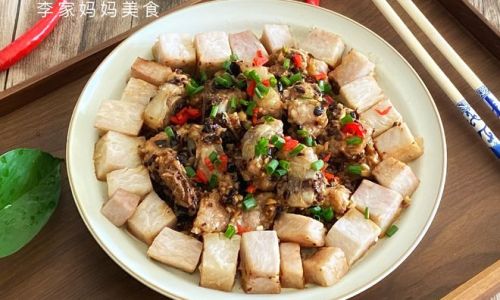
Marinating the pork ribs is crucial for flavor development. This step allows the seasonings to penetrate the meat, ensuring every bite is flavorful.
1 Marinade Preparation
In a mixing bowl, combine:
- 2 tablespoons of light soy sauce
- 1 tablespoon of dark soy sauce
- 1 tablespoon of Shaoxing wine
- 1 teaspoon of sesame oil
- 1/2 teaspoon of white pepper
- 2 cloves of garlic, finely chopped
- A small handful of ginger strips
Mix well to create a homogeneous marinade.
2 Marinating Process
Add the prepared pork ribs to the marinade, ensuring they are evenly coated. Cover the bowl with plastic wrap or transfer to a zip-top bag and refrigerate for at least 2 hours, preferably overnight for maximum flavor absorption.
Section 3: Preparing the Steaming Dish
1 Assembling the Ingredients
Once the pork ribs have marinated, it’s time to assemble the steaming dish. You’ll need a heatproof steaming tray or dish that fits snugly inside your steamer basket.
- Drain the marinated pork ribs, reserving the marinade for later use.
- Arrange the pork ribs in a single layer on the steaming tray.
- Place the taro root pieces around and between the ribs, ensuring they are not overcrowded to allow for even steaming.
2 Adding Aromatics and Marinade

Scatter the remaining garlic and ginger pieces over the pork and taro. Pour the reserved marinade evenly over the top, ensuring it covers both the meat and vegetables. This will add an extra layer of flavor during steaming.
Section 4: The Steaming Process
1 Setting Up the Steamer
Fill the base of your steamer with water, ensuring it does not touch the steaming tray. Bring the water to a rolling boil over high heat.
2 Steaming the Dish
Carefully place the steaming tray with the pork ribs and taro root into the steamer basket. Cover with the steamer lid and reduce the heat to medium-high to maintain a steady, gentle steam.
- Steaming Time: Depending on the size and thickness of the pork ribs and taro root, steaming time can range from 45 minutes to 1 hour. The key is to steam until the pork is tender and can be easily pulled apart with a fork, and the taro root is soft and creamy.
3 Checking for Doneness
Use a food thermometer to check the internal temperature of the thickest piece of pork; it should reach 145°F (63°C) for medium-doneness. Alternatively, insert a chopstick or fork into the center of a rib; it should slide in and out with little resistance.
Section 5: Finishing Touches and Serving
1 Garnishing
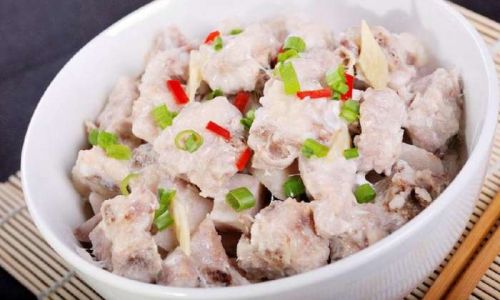
Once the pork ribs and taro root are cooked to perfection, remove the steaming tray from the steamer and let it rest for a few minutes. This allows the flavors to meld and the juices to redistribute.
- Sprinkle chopped spring onions and coriander leaves over the top for a burst of fresh flavor and color.
- Drizzle a little extra sesame oil over the dish for added aroma and richness.
2 Serving
Serve the Steamed Taro Root and Pork Ribs hot, straight from the steaming tray. It pairs wonderfully with a side of steamed rice, absorbing the savory juices and enhancing the overall dining experience.
Section 6: Tips and Variations
1 Tips for Perfect Steaming
- Ensure your steamer is well-sealed to retain steam and heat.
- Avoid opening the steamer lid frequently during cooking, as this can release steam and prolong cooking time.
- Use a food thermometer for accuracy when checking doneness, especially if you’re new to steaming.
2 Creative Variations
- Add a touch of sweetness by incorporating a few slices of fresh pineapple or pear into the steaming tray.
- For a spicy kick, sprinkle some chili flakes or add a few slices of fresh chili over the dish before steaming.
- Experiment with different herbs and spices, such as five-spice powder or star anise, to infuse the dish with unique flavors.
Conclusion
Steamed Taro Root and Pork Ribs is a dish that embodies the essence of traditional Chinese cuisine: simple, yet deeply flavorful, and nutritious. By following this comprehensive guide, you’ll be able to create a dish that not only satisfies the palate but also brings a sense of warmth and nostalgia to the table. Whether you’re serving it to family and friends or enjoying it as a comforting meal for one, this dish promises to deliver an unforgettable culinary experience. Happy steaming!
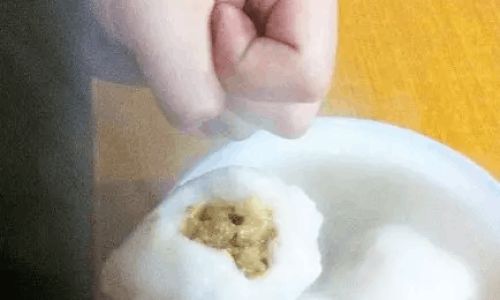
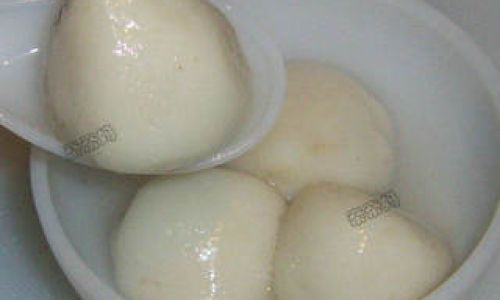

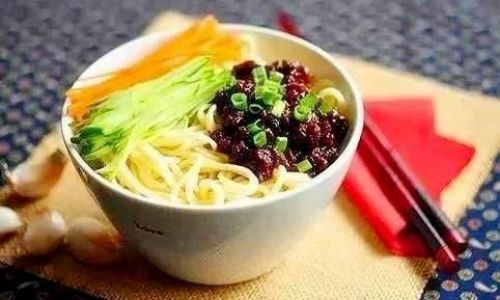
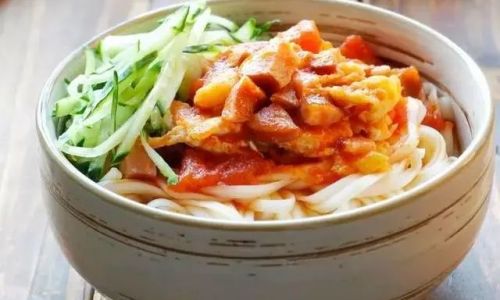
0 comments